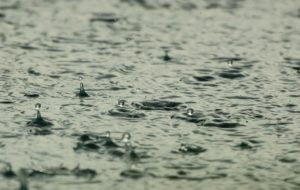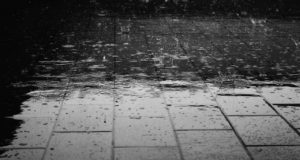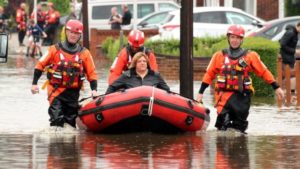 There are rain drops on my window panes and puddles in my garden. When I draw back the curtains in the morning I am greeted by a pendulous sky, not pearly opalescence, nor the thrumming, blue-black cloud of dramatic tempest-to-come, but a grim, uniform greyness.
There are rain drops on my window panes and puddles in my garden. When I draw back the curtains in the morning I am greeted by a pendulous sky, not pearly opalescence, nor the thrumming, blue-black cloud of dramatic tempest-to-come, but a grim, uniform greyness.
Is it cold? No. But somehow it feels cold. I pass over my T-shirts in the drawer and reach for something long-sleeved. Increasingly, this seems to be the weather of a  British Summer. It cannot have escaped notice that our weather is changing. People say that, for about a decade now, we have had a cold, wet August, a rainy season. Hmmm…. Time to have fun with stats (not a contradiction in terms but, maybe, the sign of an anal personality)?
British Summer. It cannot have escaped notice that our weather is changing. People say that, for about a decade now, we have had a cold, wet August, a rainy season. Hmmm…. Time to have fun with stats (not a contradiction in terms but, maybe, the sign of an anal personality)?
London and the Thames Basin has definitely been getting hotter. Between 1961 and 1990 the average August temperature was 21 – 22ºC. This rises to over 22º after 1990. During the period 1980 to 2010 London is warmer and drier on average than the rest of the UK, receiving 51mm of rain in August, with 211 hours of sunshine and an average high temperature of 23ºC. Compare this with the UK average for the same period of nearly 90mm of rain, 163 hours of sunshine and an average high temperature of 19º.
But, has it been getting rainier? Well, yes and no.
There is a lot of data. Weather has been recorded across Britain from the 1640s and, thanks to Robert Fitzroy, on a fairly systematic basis from the nineteenth century.  Fitzroy appears as the Captain of HMS Beagle, along with Charles Darwin and other luminaries in the late Harry Thompson’s wonderful, Booker listed 2005 historical novel This Thing of Darkness. This is remarkable fiction about real people, which I can highly recommend. One of the reasons we have lots of stats is Fitzroy’s belief that practical, scientifically based weather forecasting was possible and his attempts to systematically collect the data which permitted it.
Fitzroy appears as the Captain of HMS Beagle, along with Charles Darwin and other luminaries in the late Harry Thompson’s wonderful, Booker listed 2005 historical novel This Thing of Darkness. This is remarkable fiction about real people, which I can highly recommend. One of the reasons we have lots of stats is Fitzroy’s belief that practical, scientifically based weather forecasting was possible and his attempts to systematically collect the data which permitted it.
Tomorrow is the 150th anniversary of the Shipping Forecast Fitzroy’s legacy. This eminently practical, life saving broadcast is, for me, also a perfect example of the romance and the exotic allure of names. Forties, Dogger, German Bight and Finisterre, the end of the world, now renamed Fitzroy.
Fitzroy’s statistics do not substantiate the claim of a mid-summer monsoon. There are rainy years and the driest ever August was in 1995, but decadel rainfall shows that, while the 2000s had more rain than the 1970s, 80s and 90s, it wasn’t, overall, out of the ordinary ( see here ).
Why then do folk believe that we’re having August monsoons ? In part it’s a fault of memory. Summer floods, we think, and remember TV pictures of Worcester and Gloucester Cathedrals turned into islands by flood waters (though I can attest to the fact that the Severn always flooded around Worcester Cathedral and across the New Road cricket ground). Yet these floods didn’t happen in August, but in Spring or Autumn.
? In part it’s a fault of memory. Summer floods, we think, and remember TV pictures of Worcester and Gloucester Cathedrals turned into islands by flood waters (though I can attest to the fact that the Severn always flooded around Worcester Cathedral and across the New Road cricket ground). Yet these floods didn’t happen in August, but in Spring or Autumn.
There are bad flooding years, especially in the West Country and York sometimes floods, given extra water in the Ouse, but they don’t tend to happen in London and the South East which, in  the past thirty years has suffered more from flooding’s opposite – drought. There are exceptions, London and the SE flooded in June 2015, for example, see photo of Barking. But, by and large, it doesn’t happen.
the past thirty years has suffered more from flooding’s opposite – drought. There are exceptions, London and the SE flooded in June 2015, for example, see photo of Barking. But, by and large, it doesn’t happen.
For which I am very grateful, because my home lies in an area of south London which, before the Thames Barrier was built, flooded regularly. When we moved here we found a newspaper cutting in the cellar from the 1960s showing our road completely underwater, which was treated as a normal occurrence.
As for the raindrops and puddles, I will tell myself that they’re nothing out of the ordinary and just wait for the sunshine. There is, I understand, to be no more rain until September. Speaking of which…..
Other articles on weather and rain are Rain Weatherland Storm Warning


 RSS – Posts
RSS – Posts